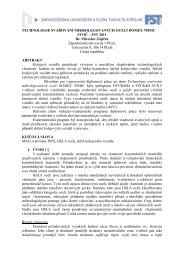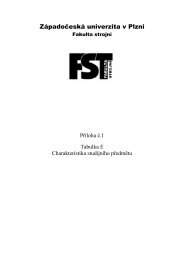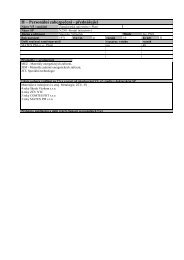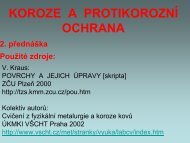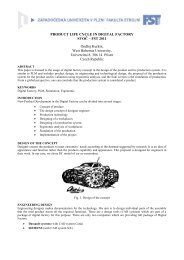the calculations of temperature fields of the forming machines
the calculations of temperature fields of the forming machines
the calculations of temperature fields of the forming machines
You also want an ePaper? Increase the reach of your titles
YUMPU automatically turns print PDFs into web optimized ePapers that Google loves.
The tables 1 and 2 shows an increase <strong>of</strong> surface <strong>temperature</strong> on <strong>the</strong> inside surface during <strong>the</strong> free forging.After removing <strong>the</strong> semiproduct <strong>the</strong>re is a very rapid cooling from 103 °C to 42 °C in 5 minutes. During a break lasting26 minutes it was cooled down up to 35.8 ° C, which is comparable to <strong>the</strong> baseline <strong>temperature</strong> (32 ° C).Table 1 - Measurement results (first part)<strong>temperature</strong>/timet 1 =0 t 2 =+14 t 3 =+21 t 4 =+28 t 5 =+35 t 6 =+40 t 7 =+1.06beforestartdie forging free forging brake brakepoint 1 (°C) 32 63,7 59,6 60,7 103,2 42,1 35,8point 2 (°C) 31,8 48,6 34,1 33,8 48,9 30,3 30,1point 3 (°C) 33,8 109,1 80 79 92,3 61,6 55point 4 (°C) 32,6 36,15 35,3 34 41,67 29,5 32,7point 5 (°C) 34,7 55,4 46,47 47,7 55,67 32 31,45In <strong>the</strong> second part <strong>of</strong> measurements we recorded a significant increase in surface <strong>temperature</strong> on <strong>the</strong> inner side <strong>of</strong> <strong>the</strong>column and in <strong>the</strong> middle point <strong>of</strong> <strong>the</strong> slide. There was a significant <strong>temperature</strong> difference between <strong>the</strong> pairs <strong>of</strong>columns and <strong>the</strong> opposite sides <strong>of</strong> <strong>the</strong> slide, caused by different heating from long semiproduct. This difference is up to64 °C, on <strong>the</strong> column and up to 69 °C on <strong>the</strong> slide.<strong>temperature</strong>/timet 8 =+1.20 t 9 =+1.30kování(začátekt 7 =+1.17)Table 2 - Measurement results (second part)t 10 =+1.40 t 12 =+1.50 t 13 =+1.55 t 14 =+2.05free forgingt 15 =+2.12press side L L L R L R L R L R L Rpoint 1(°C) 55,3 59,5 55,2 105 49 113 68 81,5 70,8 74,5 49,2point 2(°C) 35,8 36,2 36,7 32,5 35,5 37 41 37 33 32point 3 (°C) 76 82,3 77 76,5 102 115 102,5 126 82 100point 4 (°C) 28,3 26,7 33,7 35,5 40 32,5 34,5 29,5 26,5 32point 5(°C) 34,8 36,5 35,7 104 33,9 81,5 35,4 101,5 36,5 72,5 32,5 66,1endFig.5 Comparison <strong>of</strong> surface <strong>temperature</strong>s on <strong>the</strong> left (35 °C) and <strong>the</strong> right side <strong>of</strong> <strong>the</strong> slide (104 °C)
TEMPERATURE CALCULATIONAs <strong>the</strong> next step in solving <strong>the</strong>rmal problems <strong>of</strong> <strong>the</strong> <strong>forming</strong> machine was carried out FEM <strong>temperature</strong> calculation. Itsaim was to determine <strong>the</strong> surface <strong>temperature</strong> <strong>of</strong> <strong>the</strong> press CKV 84/105 for comparison with measurements. Its servedfor fur<strong>the</strong>r calculation calibration. This knowledge can be used in future <strong>calculations</strong> for o<strong>the</strong>r <strong>the</strong>rmal calculation on<strong>forming</strong> machine.A simplified model was created by available documentation in <strong>the</strong> program Gambit for calculation by FEM - Fluent.Boundary conditionsAmbient <strong>temperature</strong>: 30 °CThe <strong>temperature</strong> <strong>of</strong> <strong>the</strong> semiproduct 1150 °CSimplification <strong>of</strong> <strong>the</strong> calculation: modelled only a quarter <strong>of</strong> <strong>the</strong> press; semiproduct permanently attached to <strong>the</strong> lowertool; <strong>the</strong> upper part <strong>of</strong> <strong>the</strong> press is fixed in one position; air flow is not considered (only <strong>the</strong> minimum necessary for <strong>the</strong>calculation).Fig.6 Model for FEM calculation in <strong>the</strong> FLUENTResults <strong>of</strong> calculationMaximum surface <strong>temperature</strong> on <strong>the</strong> inner side <strong>of</strong> <strong>the</strong> press column reaches 214 ° C.This is <strong>the</strong> maximum <strong>temperature</strong>, which may be on <strong>the</strong> surface structure - column - warmed to <strong>the</strong> steady-state <strong>of</strong> <strong>the</strong><strong>the</strong>rmal system.Obr.7 Results <strong>of</strong> <strong>temperature</strong> calculation – surface <strong>temperature</strong>s
The figure 8 shows <strong>the</strong> section headed by <strong>the</strong> center <strong>of</strong> <strong>the</strong> column. Warming up <strong>the</strong> column throughout <strong>the</strong> thickness <strong>of</strong><strong>the</strong> inner side can be seen in <strong>the</strong> range <strong>of</strong> 195 ° C - 214 ° C. From <strong>the</strong> outside, up to about half <strong>the</strong> height <strong>of</strong> <strong>the</strong> column<strong>temperature</strong> is <strong>the</strong> same, <strong>the</strong> <strong>temperature</strong> drops to values between 176 ° C - 195 ° C. Warming <strong>of</strong> <strong>the</strong> slide is in <strong>the</strong> samerelations.THERMAL TIME CALCULATIONFig.8 Results <strong>of</strong> <strong>temperature</strong> calculation – cross sectionThe next logical step in solving <strong>the</strong> <strong>temperature</strong> problem was <strong>the</strong> introduction time in <strong>the</strong> <strong>temperature</strong> calculation.Boundary conditions were maintained <strong>the</strong> same as for steady-state calculation: <strong>temperature</strong> 30 °C, <strong>the</strong> <strong>temperature</strong> <strong>of</strong><strong>the</strong> semiproduct 1150 °C.Results <strong>of</strong> calculationThe maximum surface <strong>temperature</strong> <strong>of</strong> <strong>the</strong> column as <strong>the</strong> middle point <strong>of</strong> slide reaches 60 - 75 °C.That result (Fig. 9) represents <strong>the</strong> state <strong>of</strong> <strong>the</strong> system after 38 minutes. This result corresponds to <strong>the</strong> insertion <strong>of</strong> <strong>the</strong>semiproduct in <strong>the</strong> second part <strong>of</strong> <strong>the</strong> measurement (Table 2).The calculation shows that about 40 minutes is too short to heat <strong>the</strong> larger structures in <strong>the</strong> existing design. Thefollowing section (Fig. 10) shows that this is only <strong>the</strong> surface <strong>temperature</strong> and calculating time period is not enough towarm this large body structure.
Fig.9 Results <strong>of</strong> <strong>the</strong>rmal time calculation (38min) - surface <strong>temperature</strong>Fig.10 Results <strong>of</strong> <strong>the</strong>rmal time calculation (38min) - cross section
Time <strong>temperature</strong> calculation was subsequently calculated to 100 minutes (Fig. 11). During this time period wasincreased to a maximum surface <strong>temperature</strong> to 105 °C and <strong>the</strong> construction <strong>of</strong> <strong>the</strong> press began to slowly warm.Maximum <strong>temperature</strong> <strong>of</strong> <strong>the</strong> inner part <strong>of</strong> <strong>the</strong> column reached 65 °C.CONCLUSIONFig.11 Results <strong>of</strong> <strong>the</strong>rmal time calculation (100min) – cross sectionVerification <strong>of</strong> <strong>the</strong> credibility was carried out <strong>of</strong> <strong>the</strong>rmal FEM calculation – in comparison with <strong>the</strong> measurement. Theresults are comparable.Calculating <strong>of</strong> <strong>temperature</strong> and <strong>temperature</strong> measurement at <strong>the</strong> press CKV 84/105 showed that in this case <strong>the</strong>rmaleffect is not significant.Concept <strong>of</strong> procedure for verifying <strong>the</strong> <strong>the</strong>rmal effect on <strong>forming</strong> <strong>machines</strong>:- use <strong>of</strong> stationary calculation - determination <strong>of</strong> <strong>the</strong> maximum <strong>temperature</strong> - <strong>the</strong>oretically possible- verification by <strong>the</strong> time calculation - if justifiableThis knowledge can be used in future <strong>calculations</strong> for o<strong>the</strong>r particular <strong>the</strong>rmal calculation on <strong>forming</strong> machine. In thisparticular case, we verified that we are able to FEM analysis <strong>of</strong> <strong>the</strong>rmal conditions on <strong>the</strong> <strong>forming</strong> <strong>machines</strong>.REFERENCES[1] RUDOLF, B., KOPECKÝ, M. Tvářecí stroje – Základy stavby a využití. Praha: SNTL, 1985.[2] KOVÁČ, A., RUDOLF, B. Tvárniace stroje. Btatislava: ALFA, 1989.[3] SEMIATIN, S, L. Forming and Forging. ASM Handbook, Volume 14. Ohio: Metals Park, 1996,ISBN 0-87170-020-4[4] RUDOLF, B., KOPECKÝ, M. Tvářecí stroje – Základy výpočtů a konstrukce. Praha: SNTL, 1982.



